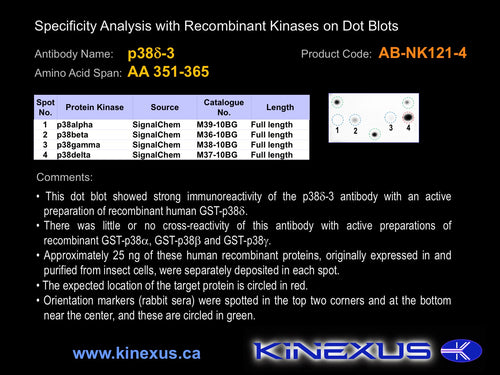Product Name:
PAK1-NT (PAK1-1)
Product Number:
ab-nk121-4
Target Full Name: p21-activated kinase 1 alpha; Protein-serine/threonine kinase PAK 1
Target Alias: ADRB2; Alpha-PAK; CDC42,RAC effector kinase PAK-A; CDC42/RAC effector kinase PAK-A; Kinase PAK1; MUK2; P21 protein (Cdc42/Rac)-activated kinase 1; P65-PAK; STE20, yeast; P68-PAK; PAK 1; PAK-1; PAKA; Protein kinase MUK2; PAKalpha; MGC130000; MGC130001; CCDS8250.1; Q13153; ENSG00000149269
Product Type Specific: Protein kinase pan-specific antibody
Antibody Code: NK122-2
Antibody Target Type: Pan-specific
Protein UniProt: Q13153
Protein SigNET: Q13153
Antibody Type: Polyclonal
Antibody Host Species: Rabbit
Antibody Immunogen Source: Human PAK1 (PAKa) sequence peptide
Antibody Immunogen Sequence: MSNNGLDVQDKPC
Antibody Immunogen Description: Corresponds to amino acid residues M1 to P12; N-terminus
Production Method: Corresponds to amino acid residues M1 to P12; N-terminus
Antibody Modification: Protein kinase pan-specific antibody
Antibody Concentration: 0.25 mg/ml
Storage Buffer: 100 mM Tris-glycine, pH 7.0
Storage Conditions: For long term storage, keep frozen at -40°C or lower. Stock solution can be kept at +4°C for more than 3 months, but either 0.1% sodium azide or 0.05% Thimerasol should be added. Avoid repeated freeze-thaw cycles.
Product Use: Western blotting | Antibody microarray
Antibody Dilution Recommended: 2 µg/ml for immunoblotting
Antibody Species Reactivity: Human; Mouse; Rat
Antibody Positive Control: The observed molecular mass of the processed target protein on SDS-PAGE gels is reported to be around 60-67 kDa.
Antibody Cross Reactivity: Cross-reactivity with 60 kDa and 90 kDa proteins in various rat tissues.
Related Product 1: PAK1-pS144 phosphosite-specific antibody (Cat. No.: AB-PK748)
Related Product 2: PAK1-pT423 phosphosite-specific antibody (Cat. No.: AB-PK749)
Related Product 3: PAktide KinSub - PAK peptide substrate
Related Product 4: PAK1Subtide - PAK1 protein kinase substrate peptide
Scientific Background: PAK1 is a protein-serine/threonine kinase that is a member of the STE group of protein kinases in the STE20 family, and PAKA subfamily. This kinase is highly expressed and widely distributed in most tested human tissues. PAK1 has been implicated in the regulation of cytoskeletal organization, and cell proliferation and survival, morphology, motility and transformation. Binding of GTP-bound Cdc42 or Rac1 to the autoregulatory region at the N-terminus of PAK1 releases monomers from the autoinhibited dimer, enables phosphorylation at T423 and activation of its phosphotransferase activity. It is also activated by binding to GTP-bound Cdc42, independent of the phosphorylation state of T423. Phosphorylation of S144, S149, and T423 increases PAK1's phosphotransferase activity, whereas phosphorylation of T84 (by OXSR1) and Y212 inhibits its phosphotransferase activity. Phosphorylation of S21 inhibits binding of Nck and PIX. PAK1 may be a therapeutic target in B-Raf wild-type melanoma. Knockdown of PAK1 has been shown to inhibit the proliferation of mutant KRAS colon cancer cells.


